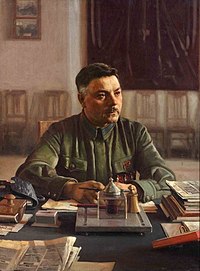Kliment Voroshylov
| Kliment Voroshilov Климе́нт Вороши́лов |
|
|---|---|

Voroshilov in his office. Portrait by Isaak Brodsky.
|
|
| Chairman of the Presidium of the Supreme Soviet of the Soviet Union | |
|
In office 15 March 1953 – 7 May 1960 |
|
| General Secretary | Nikita Khrushchev |
| Preceded by | Nikolay Shvernik |
| Succeeded by | Leonid Brezhnev |
| People's Commissar for Defense of the Soviet Union | |
|
In office 6 November 1925 – 7 May 1940 |
|
| Premier |
Alexey Rykov Vyacheslav Molotov |
| Preceded by | Mikhail Frunze |
| Succeeded by | Semyon Timoshenko |
| Full member of the 14th, 15th, 16th, 17th, 18th, 19th, 20th–21st Presidium | |
|
In office 1 January 1926 – 16 July 1960 |
|
| Personal details | |
| Born |
Kliment Yefremovich Voroshilov 4 February 1881 Lysychansk, Russian Empire |
| Died | 2 December 1969 (aged 88) Moscow, Russian SFSR, Soviet Union |
| Nationality | Soviet |
| Political party | Communist Party of the Soviet Union |
| Spouse(s) | Ekaterina Davidovna |
| Awards |
|
| Military service | |
| Allegiance |
|
| Service/branch |
Russian Imperial Army Soviet Army |
| Years of service | 1917–1953 |
| Rank | Marshal |
| Commands |
North Caucasus Military District Moscow Military District Leningrad Front |
| Battles/wars | World War I Russian Civil War Polish–Soviet War Winter War Eastern Front (World War II) |
Kliment Yefremovich Voroshilov (Russian: ![]() Климе́нт Ефре́мович Вороши́лов Kliment Jefremovič Vorošilov, Ukrainian: Климент Охрімович Ворошилов, Klyment Ochrimovyč Vorošylov), popularly known as Klim Voroshilov (Russian: Клим Вороши́лов, Klim Vorošilov) (4 February 1881 – 2 December 1969), was a prominent Soviet military officer and politician during the Stalin era. He was one of the original five Marshals of the Soviet Union (the highest military rank of the Soviet Union), along with Chief of the General Staff of the Red Army Alexander Ilyich Yegorov, and three senior commanders, Vasily Blyukher, Semyon Budyonny, and Mikhail Tukhachevsky.
Климе́нт Ефре́мович Вороши́лов Kliment Jefremovič Vorošilov, Ukrainian: Климент Охрімович Ворошилов, Klyment Ochrimovyč Vorošylov), popularly known as Klim Voroshilov (Russian: Клим Вороши́лов, Klim Vorošilov) (4 February 1881 – 2 December 1969), was a prominent Soviet military officer and politician during the Stalin era. He was one of the original five Marshals of the Soviet Union (the highest military rank of the Soviet Union), along with Chief of the General Staff of the Red Army Alexander Ilyich Yegorov, and three senior commanders, Vasily Blyukher, Semyon Budyonny, and Mikhail Tukhachevsky.
Voroshilov was born in the settlement of Verkhnye, Bakhmut district (uyezd), Yekaterinoslav Governorate (now part of Lysychansk city in Luhansk Oblast, Ukraine), in the Russian Empire, into a railway worker's family of Russian ethnicity. However, according to the Soviet Major General Pyotr Grigorenko, Voroshilov himself alluded to his Ukrainian heritage and to the previous family name of Voroshilo. Voroshilov joined the Bolshevik faction of the Russian Social Democratic Labour Party in 1905. Following the Russian Revolution of 1917, Voroshilov became a member of the Ukrainian Council of People's Commissars and Commissar for Internal Affairs along with Vasiliy Averin. He was well known for aiding Joseph Stalin in the Military Council (led by Leon Trotsky), having become closely associated with Stalin during the Red Army's 1918 defense of Tsaritsyn. Voroshilov was active as a commander of the Southern Front during the Russian Civil War and the Polish–Soviet War while with the 1st Cavalry Army. As Political Commissar serving co-equally with Stalin, Voroshilov was responsible for the morale of the 1st Cavalry Army, which was composed chiefly of peasants from southern Russia. Voroshilov's efforts as Commissar did not prevent a resounding Polish victory at the Battle of Komarów (1920) or regular outbreaks of murderous anti-Semitic violence within the Cavalry army's ranks.
...
Wikipedia
